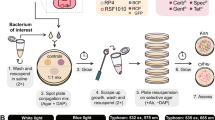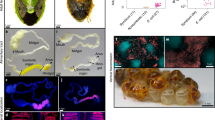Abstract
In our previous study we isolated 10 bacterial species from fourth-instar larval midguts of the red imported fire ant, Solenopsis invicta. Here we report the genetic transformation and reintroduction of three species (Kluyvera cryocrescens, Serratia marcescens, and isolate 38) into the fire ant host. All three species were transformed with the plasmid vector, pZeoDsRed. High expression levels of DsRed were observed and the plasmid is maintained in these bacteria at 37°C in the absence of antibiotic selection for at least 9 days of subculturing. The transformed bacteria were successfully reintroduced into fire ant larvae and survived in the fire ant gut for at least 7 days. Upon pupal emergence, 7 days after reintroduction, transformed bacteria can still be isolated, however, most were passed out in the meconium. We further demonstrated that the engineered bacteria could be spread within the colony by feeding this meconium to naive larvae with the aid of worker fire ants.

Similar content being viewed by others
References
Beard CB, Cordon-Rosales C, Durvasula RV (2002) Bacterial symbionts of the triatominae and their potential use in control of Chagas disease transmission. Annu Rev Entomol 47:123–141
Bextine BR, Thorvilson HG (2002) Monitoring Solenopsis invicta (Hymenoptera: Formicidae) foraging with peanut oil-baited, UV-reflective Beauveria alginate pellets. Southwest Entomol 27:31–36
Bextine BR, Lauzon C, Potter S et al (2004) Delivery of a genetically marked Alcaligenes sp. to the glassy-winged sharpshooter for use in a paratransgenic control strategy. Curr Microbiol 48:327–331
Buchner P (1965) Endosymbiosis of animals with plant microorganisms. Intersciences, New York
Dotson EM, Plikaytis B, Shinnick TM et al (2003) Transformation of Rhodococcus rhodnii, a symbiont of the Chagas disease vector Rhodnius prolixus, with integrative elements of the L1 mycobacteriophage. Infect Genet Evol 3:103–109
Drees BM, Miller RW, Vinson SB et al (1992) Susceptibility and behavioral response of red imported fire ant (Hymenoptera: Formicidae) to selected entomogenous nematodes (Rhabditida: Steinernematidae & Heterorhabditidae). J Econ Entomol 85:365–370
Drees BM, Barr CL, Vinson SB, et al. (1996) Managing red imported fire ants in urban areas. Texas Agricultural Extension Service Regional Report, pp 1–18
Durvasula RV, Gumbs A, Panackal A et al (1997) Prevention of insect-borne disease: an approach using transgenic symbiotic bacteria. Proc Natl Acad Sci USA 94:3274–3278
Gerdes K, Rasmussen PB, Molin S (1986) Unique type of plasmid maintenance function: post-segregational killing of plasmid free cells. Proc Natl Acad Sci USA 83:3116–3120
Lard C, Willis DB, Salin V et al (2002) Economic assessments of red imported fire ant on Texas’ urban and agricultural sectors. Southwest Entomol 25:123–137
Lee AH, Husseneder C, Hooper-Bùi L (2008) Culture-independent identification of gut bacteria in fourth-instar red imported fire ant, Solenopsis invicta Buren, larvae. J Invertebr Pathol 98:20–33
Li H, Medina F, Vinson SB et al (2005) Isolation, characterization and molecular identification of bacteria from the red imported fire ant (Solenopsis invicta) Midgut. J Invertebr Pathol 89:203–209
Peloquin JJ, Lauzon CR, Potter S et al (2002) Transformed bacterial symbionts re-introduced to and detected in host gut. Curr Microbiol 45:41–45
Petralia RS, Vinson SB (1978) Feeding larva of the imported fire ant, Solenopsis invicta Buren: behavior and morphological adaptions. Ann Entomol Soc Am 71:643–648
Porter SD (1998) Biology and behaviour of Pseudacteon decapitating flies (Diptera: Phoridae) that parasitize Solenopsis fire ants (Hymenoptera: Formicidae). Fla Entomol 81:292–308
Porter SD, Alonso LE (1999) Host specificity of fire ant decapitating flies (Diptera: Phoridae) in laboratory oviposition trials. J Econ Entomol 92:110–114
Robertson HM, Lampe DJ (1995) Recent horizontal transfer of a mariner transposable element among and between Diptera and Neuroptera. Mol Biol Evol 12:850–862
Thorvilson HG, Philips SA, Sorenson AA Jr et al (1987) The straw itch mite, Pyemotes tritici (Acari: Pyemotidae), as a biological control agent or red imported fire ants, Solenopsis invicta (Hymenoptera: Formicidae). Fla Entomol 70:440–444
Vinson SB (1997) Invasion of the red imported fire ant (Hymenoptera: Formicidae): spread, biology, and impact. Am Entomol 43:23–39
Vinson SB, Sorensen AA (1986) Imported fire ant: life history and impact. Bulletin of Texas Department of Agriculture, pp 8–17
Williams DF, Oi DH, Knue GJ (1999) Infection of red imported fire ant (Hymenoptera: Formicidae) colonies with the entomopathogen Thelohania solenopsae (Microsporidia: Thelohaniidae). J Econ Entomol 92:830–836
Acknowledgments
This work was supported by a grant from the Texas Imported Fire Ant Research and Management Project. We are grateful to Dr. John Peloquin (Department of Entomology, University of California, Riverside) for providing us with the pZeoDsRed plasmid, and to Sherry Ellison (Entomology Research Laboratory, Texas A&M University) for her valuable support in maintaining the fire ant colonies.
Author information
Authors and Affiliations
Corresponding author
Additional information
Freder Medina and Haiwen Li have contributed equally to this work.
Rights and permissions
About this article
Cite this article
Medina, F., Li, H., Vinson, S.B. et al. Genetic Transformation of Midgut Bacteria from the Red Imported Fire Ant (Solenopsis invicta). Curr Microbiol 58, 478–482 (2009). https://doi.org/10.1007/s00284-008-9350-2
Received:
Accepted:
Published:
Issue Date:
DOI: https://doi.org/10.1007/s00284-008-9350-2




